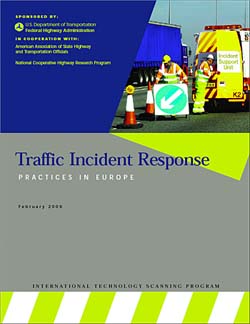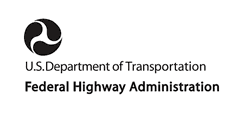U.S. Department of Transportation
Federal Highway Administration
1200 New Jersey Avenue, SE
Washington, DC 20590
202-366-4000


FHWA-PL-06-002 HPIP/1-06(3.5)EW
The Federal Highway Administration provides high-quality information to serve Government, industry, and the public in a manner that promotes public understanding. Standards and policies are used to ensure and maximize the quality, objectivity, utility, and integrity of its information. FHWA periodically reviews quality issues and adjusts its programs and processes to ensure continuous quality improvement.
Effective response to traffic incidents can enhance safety and mobility for both road users and responders. The Federal Highway Administration, American Association of State Highway and Transportation Officials, and National Cooperative Highway Research Program sponsored a scanning study of traffic incident response practices, procedures, and technologies in England, Germany, the Netherlands and Sweden.
During its study, the scan team observed several common attributes among the organizations in each country involved with incident response. They include a national authority with responsibility for coordinating incident response, national transportation agencies with traffic patrols that respond to incidents, clear jurisdictional responsibility for the police authority responding to incidents in an area, coordinated training for all major incident responders, and national auto clubs that provide roadside repair and towing services.
The team developed 25 recommendations for potential implementation in the United States. They include adopting a national goal for incident response, developing national guidance on incident response performance measures, and establishing Transportation Operations Centers of Excellence for incident response research. The recommendations are aligned with the focus areas of the National Traffic Incident Management Coalition, which plans to participate in implementing the team's recommendations.
Form DOT F 1700.7 (8-72)
Reproduction of completed page authorized
| Team Member | Organization |
|---|---|
| John Conrad (Co-Chair) | Washington State DOT |
| David Helman (Co-Chair) | FHWA |
| Rebecca Brewster | American Transportation Research Institute |
| John Corbin | Wisconsin DOT |
| Henry deVries | New York State Police |
| Dr. Gene Hawkins (Report Facilitator) | Texas A&M University |
| Gregory Jones | FHWA |
| Kevin McGinnis | National Association of State EMS Directors |
| Ron Moore | McKinney, TX, Fire Department |
| Mark Olson | FHWA |
| Larry Tibbits | Michigan DOT |
| Michael Zezeski | Maryland State Highway Administration |
and American Trade Initiatives, Inc. for the Federal Highway Administration U.S. Department of Transportation American Association of State Highway and Transportation Officials National Cooperative Highway Research Program
The International Technology Scanning Program, sponsored by the Federal Highway Administration (FHWA), the American Association of State Highway and Transportation Officials (AASHTO), and the National Cooperative Highway Research Program (NCHRP), accesses and evaluates innovative foreign technologies and practices that could significantly benefit U.S. highway transportation systems. This approach allows for advanced technology to be adapted and put into practice much more efficiently without spending scarce research funds to recreate advances already developed by other countries.
FHWA and AASHTO, with recommendations from NCHRP, jointly determine priority topics for teams of U.S. experts to study. Teams in the specific areas being investigated are formed and sent to countries where significant advances and innovations have been made in technology, management practices, organizational structure, program delivery, and financing. Scan teams usually include representatives from FHWA, State departments of transportation, local governments, transportation trade and research groups, the private sector, and academia.
After a scan is completed, team members evaluate findings and develop comprehensive reports, including recommendations for further research and pilot projects to verify the value of adapting innovations for U.S. use. Scan reports, as well as the results of pilot programs and research, are circulated throughout the country to State and local transportation officials and the private sector. Since 1990, approximately 70 international scans have been organized on topics such as pavements, bridge construction and maintenance, contracting, intermodal transport, organizational management, winter road maintenance, safety, intelligent transportation systems, planning, and policy.
The International Technology Scanning Program has resulted in significant improvements and savings in road program technologies and practices throughout the United States. In some cases, scan studies have facilitated joint research and technologysharing projects with international counterparts, further conserving resources and advancing the state of the art. Scan studies have also exposed transportation professionals to remarkable advancements and inspired implementation of hundreds of innovations. The result: large savings of research dollars and time, as well as significant improvements in the Nation's transportation system.
Scan reports can be obtained through FHWA free of charge by e-mailing international@fhwa.dot.gov. Scan reports are also available electronically and can be accessed on the FHWA's Office of International Programs Web Site at www.international.fhwa.dot.gov
International Technology Scanning Program: Bringing Global Innovations to U.S. Highways
All Publications are Available on the Internet at www.international.fhwa.dot.gov
Recent U.S. transportation studies have shown that 50 to 60 percent of all congestion in urban areas is caused by nonrecurring events and about half of that is caused by traffic incidents such as crashes, spilled loads, and disabled vehicles. That proportion is substantially higher on rural highways. Effective response to these incidents can have a significant benefit on traffic safety and mobility in both urban and rural environments. This scanning study was conducted to examine programs and practices that provide coordinated response to traffic incidents.
In April 2005, a team of 12 incident response specialists from the United States visited four European countries to assess and evaluate various practices for responding to traffic incidents. Team members included transportation agency personnel from State agencies and the Federal Highway Administration (FHWA) and individuals representing several perspectives involved in incident response, including police, fire, emergency medical services, trucking, and research. During the 2-week scan, the team met with members of about 30 organizations representing a broad range of incident response stakeholders. From these hosts, the team heard numerous presentations about traffic incident response practices from a variety of perspectives, including road authorities, fire departments, police agencies, emergency medical services (EMS), automobile clubs, recovery providers, and other groups. The team also saw many examples of responder equipment. From the information obtained during the scan, the team identified several areas where practices in the United States have the potential to be improved. This report describes the team's findings and recommendations.
The traffic incident response (TIR) study began in December 2003 with the completion of a desk scan that recommended England, Germany, the Netherlands, and Sweden as the four countries to visit during the trip. The initial team meeting occurred in June 2004 in Washington, DC, and the trip took place April 8-24, 2005. The purpose of the trip was to identify practices, issues, challenges, and innovative procedures that the host countries use in responding to incidents. The major focus of the team members was on the activities and coordination efforts that take place after an incident is detected. The team members were interested in a wide range of perspectives, including those of transportation agencies (at all levels) and emergency responders (fire, police, EMS), as well as removal efforts, traffic control at the incident site, communication between the various stakeholders, and related issues.
The team's recommendations can best be appreciated if one has an understanding of the working relationships among and between the pertinent organizations in the various countries. There were several generally common attributes among the organizations in each country involved in incident response:
The team members learned about many interesting practices, policies, technologies, and programs during the scan. At the end of the 2-week visit, the team met for a day to review the scan findings and develop 25 recommendations for potential implementation in the United States. The team members recognize that some of these recommendations may already be in place at some locations in the United States, but they believe they should be implemented uniformly at the State and/or national level. The recommendations are organized to be consistent with the three focus topics identified by the National Traffic Incident Management Coalition (NTIMC): 1) programs and institutions, 2) tactical and onscene management, and 3) communications and technology. Several team members are involved in coalition activities and the coalition is taking a major role in implementing the recommendations.
Six of the 25 recommendations are associated with programs and institutional issues that represent the strategic aspects of incident response and address how countries, organizations, and individuals approach the basic challenge of developing and coordinating incident response programs. The six recommendations address the following subjects:
Seventeen of the 25 recommendations are associated with tactical and onscene operations issues that address the activities of responders at an incident site and the onscene coordination of the various responders. The 17 recommendations address the following subjects:
Two of the 25 recommendations are associated with communication and technology issues that address how responders communicate with each other (particularly interagency communications) and with travelers, and how technologies can be used to improve incident response and management. The two recommendations address the following subjects:
In addition to the recommendations, the team observed many unique, interesting, or otherwise noteworthy practices and technologies that team members believed were worth describing to U.S. practitioners. No recommendations are associated with these observations; they are merely provided as seeds for thought. The findings include the following:
| Next >> |